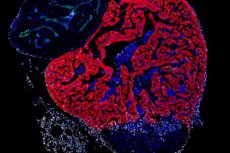New publications
New study reveals key role of mitochondrial proteins in heart regeneration
Last reviewed: 02.07.2025

All iLive content is medically reviewed or fact checked to ensure as much factual accuracy as possible.
We have strict sourcing guidelines and only link to reputable media sites, academic research institutions and, whenever possible, medically peer reviewed studies. Note that the numbers in parentheses ([1], [2], etc.) are clickable links to these studies.
If you feel that any of our content is inaccurate, out-of-date, or otherwise questionable, please select it and press Ctrl + Enter.

Mitochondria play a critical role in providing the energy needed for proper cell function. In mitochondria, energy is produced by the respiratory chain, which consists of five complexes, designated CI-CV. These complexes can assemble into supercomplexes, but little is known about the role of this process and its control.
The new study examines the mechanisms of supercomplex assembly and reveals a significant impact of mitochondrial assembly factors on cardiac tissue regeneration. The study was co-led by Dr. José Antonio Enríquez of the National Center for Cardiovascular Research (CNIC) and Dr. Nadia Mercader of the University of Bern in Switzerland, who is a visiting scientist at CNIC.
A study published in the journal Developmental Cell shows that the protein family member Cox7a plays a fundamental role in the assembly of CIV dimers and that this assembly is critical for the proper functioning of mitochondria and therefore for cellular energy production.
The Cox7a protein family includes three members: Cox7a1, Cox7a2, and Cox7a2l (also called SCAF1). Previous studies by both groups have shown that when CIV contains SCAF1, it strongly associates with CIII, forming a respiratory supercomplex known as the respirasome. In these previous studies, the authors hypothesized that inclusion of Cox7a2 would result in CIV that is unable to associate, while CIV molecules containing Cox7a1 would associate to form CIV homodimers. The new study experimentally demonstrates a role for Cox7a1 in the formation of these CIV homodimers.

Developmental Cell (2024). DOI: 10.1016/j.devcel.2024.04.012
Working with a zebrafish model, the researchers found that the absence of Cox7a1 prevented the formation of CIV dimers, and the loss of these dimers affected the weight and swimming ability of affected fish.
“Cox7a1 is primarily expressed in striated muscle cells, and it was skeletal muscle tissue that suffered the most from the lack of Cox7a1 function. The other major type of striated muscle is cardiac muscle, or myocardium,” explained Dr. Enriquez.
However, while loss of Cox7a1 in skeletal muscle was detrimental, its absence in cardiac muscle improved the cardiac regenerative response to injury.
"This result shows that these proteins play a key role in activating the heart's ability to repair itself after injury," explained first author of the study, Carolina Garcia-Pojatos.
To further explore the function of Cox7a1, CNIC researchers Enrique Calvo and Jesús Vásquez conducted a proteomic study of skeletal muscle and myocardium in zebrafish lacking Cox7a1. This analysis was complemented by a metabolomics study conducted by colleagues at the University of Bern. This combined analysis revealed significant differences from unmodified fish with intact Cox7a1 expression.
"These results suggest that molecules involved in the assembly of mitochondrial supercomplexes may have significant effects on metabolic control, possibly opening the way to new treatments for heart disease and other metabolic conditions," said Dr. Mercader.
According to the research team, this discovery represents "a significant step forward in understanding the cellular mechanisms involved in cardiac regeneration and may point the way to the development of therapies aimed at stimulating cardiac regeneration."
The authors conclude that mitochondrial assembly factors can significantly influence metabolic control.
